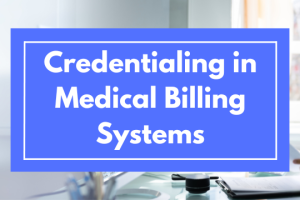Coding and Billing Best Practices
Medical coding and billing is a tedious, complex field. It requires dedicated expertise and experience and can still get confusing even for the most seasoned pros. Fortunately, private practices can optimize their coding and billing efforts so that there are fewer errors and more revenue. An extreme level of accuracy is required for effective billing and coding. Even the smallest errors can create serious issues for a practice or patient.
For example, if a procedure gets typed into the computer incorrectly, it may be billed incorrectly and therefore denied by the insurance company—and all because of basic human error. Then, the provider must re-submit the authorization and wait for approval all over again—this leads to delays in patient care, which is costly. To reduce issues and increase revenue potential, it’s important to employ the best practices of medical billing and coding.
What are Coding and Billing?
Medical coding is a complex process that takes a patient’s written medical history and translates it into a universal shorthand that is used to submit bills to the insurance company. Every single diagnosis, procedure, and treatment has a unique code that determines the costs. Once the coding is done, the information is filed with a billing claim and sent to the insurance company. The insurance company will evaluate and pay the claim based on the available coverage.
For example, the most common code submitted is the EM code, which stands for evaluation of management. This singular code is used to describe a “check-up” style visit or general examination, which most insurance policies cover. It’s a fairly easy code to bill and get paid for. However, something like cardiology where there are five or 10 CPT codes in a single bill can get a bit more complex.
Medical billing is the broader field of submitting claims to health insurance providers so that practitioners can be reimbursed for their services. In private practice, medical billing is sometimes outsourced, or handled by a single person in the office. Billing needs to be handled in a timely and accurate manner to ensure full reimbursement and maximum revenue for your practice.
Pay Attention to Reimbursements and AR
Too often, private practices that are new to the world of business put far too much faith in payors to reimburse claims. They assume that every claim that is submitted will be paid in full, but that’s not necessarily the case. It’s a lot more common for insurance companies to underpay because they don’t want to give more money than they have to.
If you aren’t paying attention to this, you’re missing out on a lot of revenue potential. You could also be giving up a lot of potential coverage for your patients by not analyzing reimbursements and checking them for accuracy. In the same regard, you must track your accounts receivables to monitor denied claims, contracts, and other issues. This will help you take a proactive approach to avoid coding and billing issues.
Keep Clean Claims High
Clean claims are the claims that were submitted to the insurance company or other payor and paid the first time around. This, of course, is the perfect outcome but it is rarely a reality of the situation. The idea is to keep your clean claims rate above 95%, meaning that only 5% of your claims don’t require a second submission, appeal, or additional paperwork of some type.
One way that you can do this is to employ practice management software that includes billing resources that can automate the billing process and streamline claims filing, eliminating the risk of human error and increasing your clean claims. You should also stay up to date with the rules and guidelines of payors to know what needs to be included. Audit yourself every six months to ensure that your processes are corrected and enhanced.
Even if you’re struggling or having issues, doing an internal audit shows that you’re trying. Payors are more likely to be lenient when providers are doing their due diligence. Even something as simple as billing for a 50-minute therapy session when it’s documented at 38 minutes can make a big difference. Get the details right.
Double-Check Claims for Accuracy
Every claim that a practitioner files needs to be checked and double-checked for accuracy and complete information. If you have someone in the office that handles all authorizations and claims, make sure that you also have another set of eyes to review their work and make sure everything is accurate. It’s nothing personal—with all the numbers, data, and details involved in medical billing, the extra look is all about making sure that information is accurate so that payments are returned in full.
According to SME, orthopedic and cardiology coding are the most complex and since the change to ICV-10 which has even more specificity in diagnoses, accurate claims are often coming down to the most minute details. She says:
- Ortho claims are difficult because of all the different bones in the body, as well as the treatment and provider notes included.
- Cardiology claims are more complex and often have as many as 10 CPT billing codes for things like ultrasound, incisions, dye, funnel catheter, and so forth.
This is where having experts in charge of billing and coding can make all the difference.
Other Challenges of Coding and Billing
Right now, SME says the three biggest pain points for billing and coding are:
- The lack or overuse of modifiers. The change to ICV-10 has many providers unsure of how to bridge the gap.
- The diagnosis or code doesn’t match what was performed or offered for treatment.
- A lot of claims are challenged or outright denied because they simply don’t meet the “medical necessity” guidelines of the provider
Payors want to see more details and a deeper explanation of the procedures themselves. Lots of accommodations need to be made to ensure that the payor has all the details they require. Of course, SME also advises that you can avoid a lot of these challenges by having a knowledge of coding and billing or having someone with that expertise on your side.
Get Back to the Basics of RCM
Perhaps you’re still new to the world of revenue cycle management. If you’ve just started a practice and you’re not sure how to proceed with billing and coding, you’ll want to brush up on your knowledge and learn as much as you can. Then, you’ll also be able to decide whether you can handle your billing and coding needs in-house or if you must outsource to a third-party provider.
Having a dedicated tool for revenue cycle management will help practice owners and their staff stick to the basics and best practices at all times and can even improve and streamline RCM in entirely new ways. Providers often get ahead of themselves or make things more difficult than necessary. With billing and coding, sticking to the basics is always best.
How Can ClinicMind RCM Software Help?
The ClinicMind EHR/RCM platform is designed to provide a total solution for revenue cycle management and practice management, including electronic health records, billing and coding, insurance management, and more. It allows users to create automated workflows and a custom dashboard that provides easy access to the necessary tools, metrics, and insights that are necessary to make key decisions.
ClinicMind also has a team of experts that have 30+ years of experience in medical billing and coding behind the software, and they can offer support and assistance to providers, as well. Built-in compliance checks and coding best practices will ensure better accuracy and more claims being paid in full and on time.
Conclusion
Practices that choose not to outsource medical billing and coding will need to know how to handle it themselves. The best practices listed here, along with the assistance of the innovative ClinicMind RCM platform, will make practice management and billing a breeze for all providers. Thanks to automation, less outsourcing is needed because the computers can do all the work to ensure that claims are filed, coded, and billed accordingly.
These best practices are designed to offer support to any private practice that is looking to better understand coding and billing. When it comes to these areas, education is everything. Hiring a team of experts to manage most of these tasks can save time and stress and make sure that you get the best outcomes when improving your medical billing and coding.










